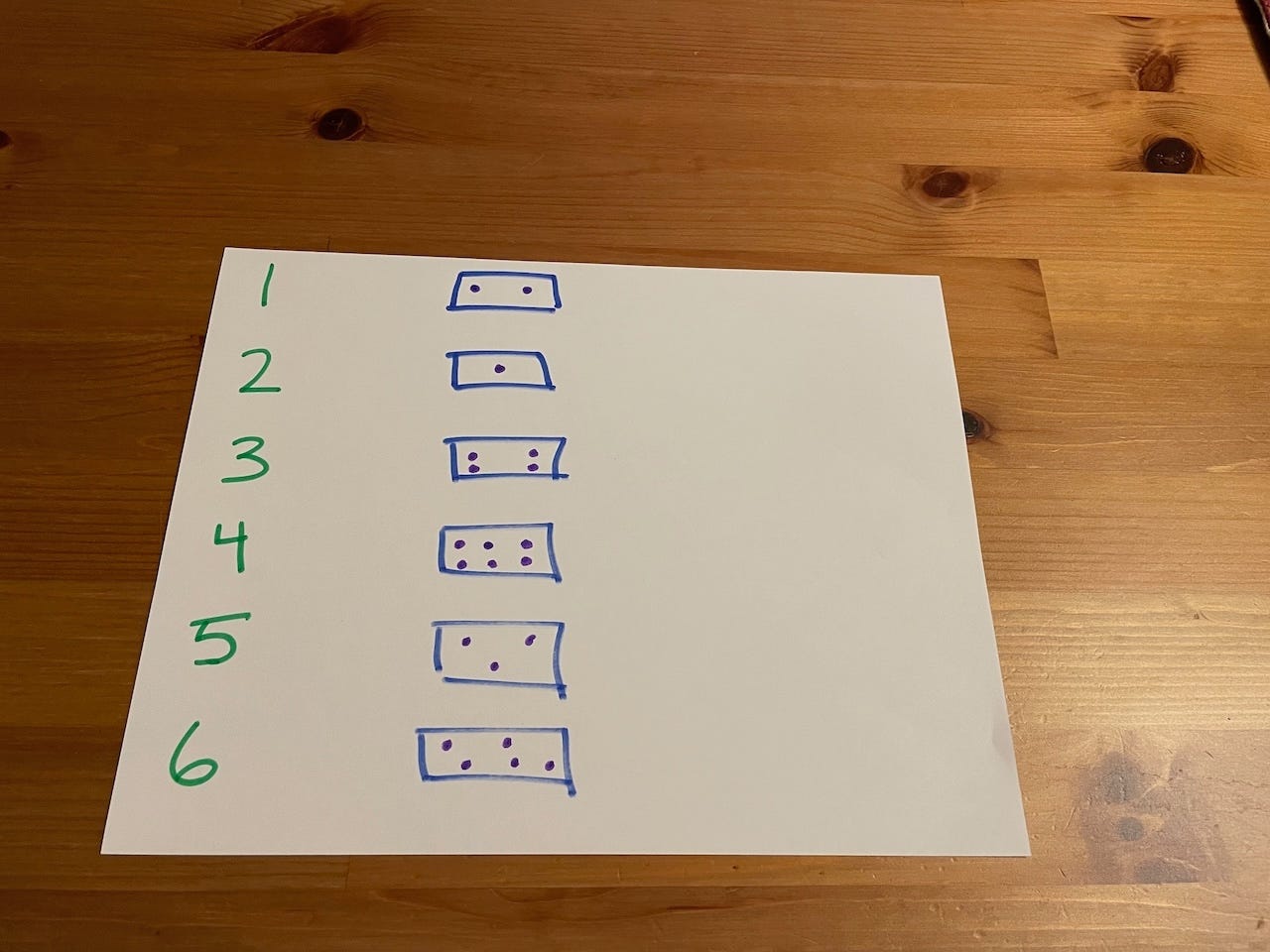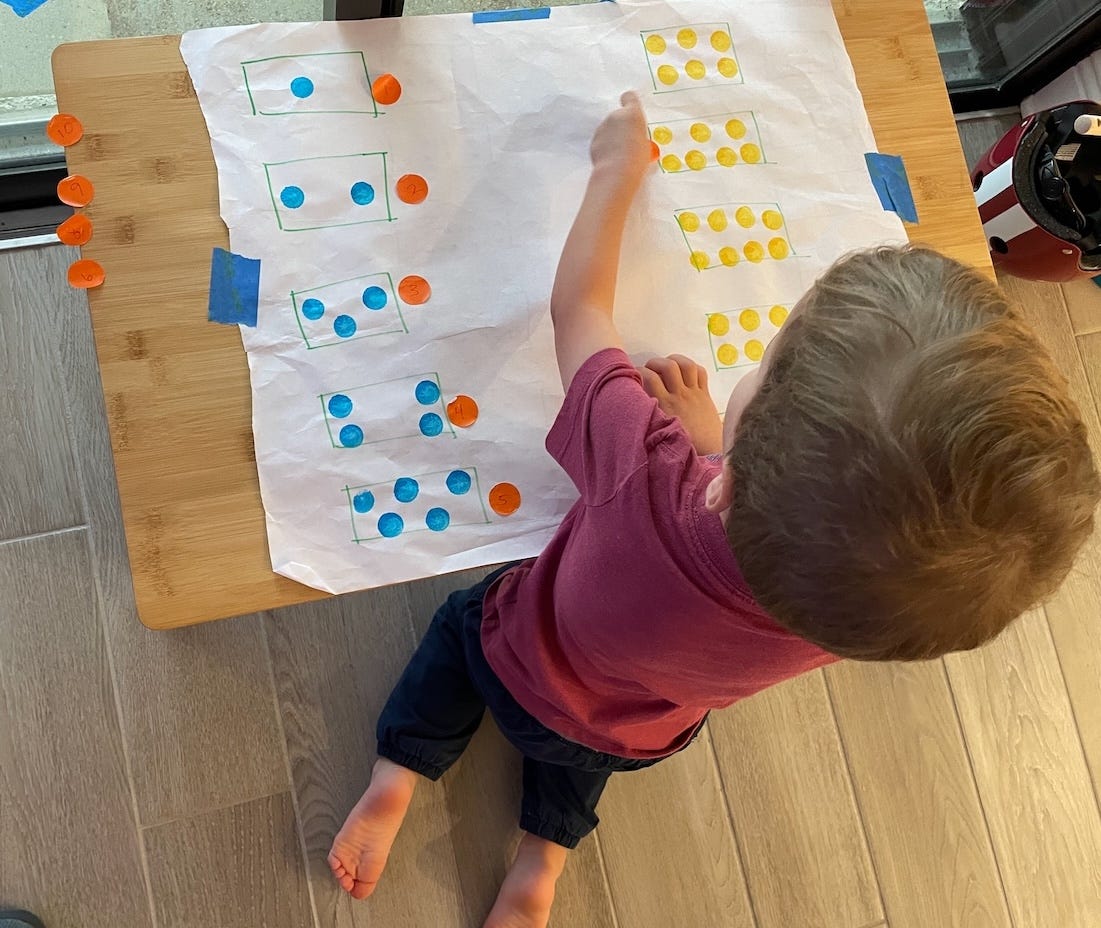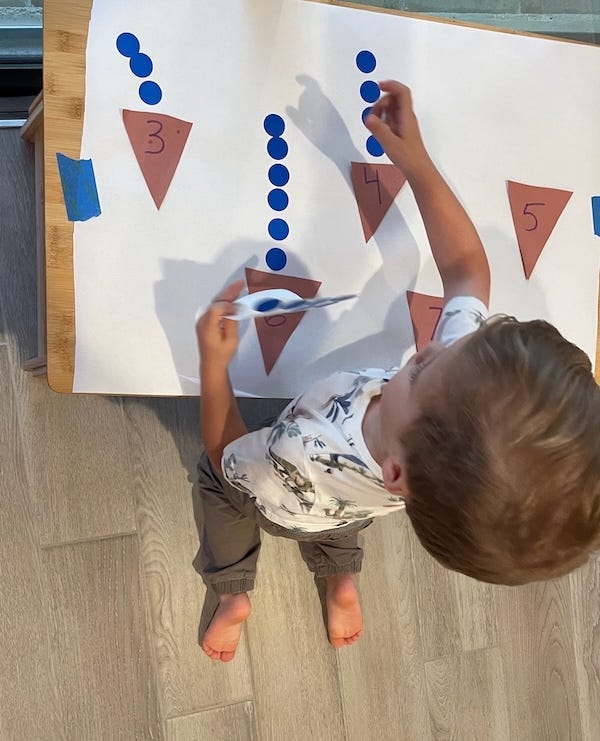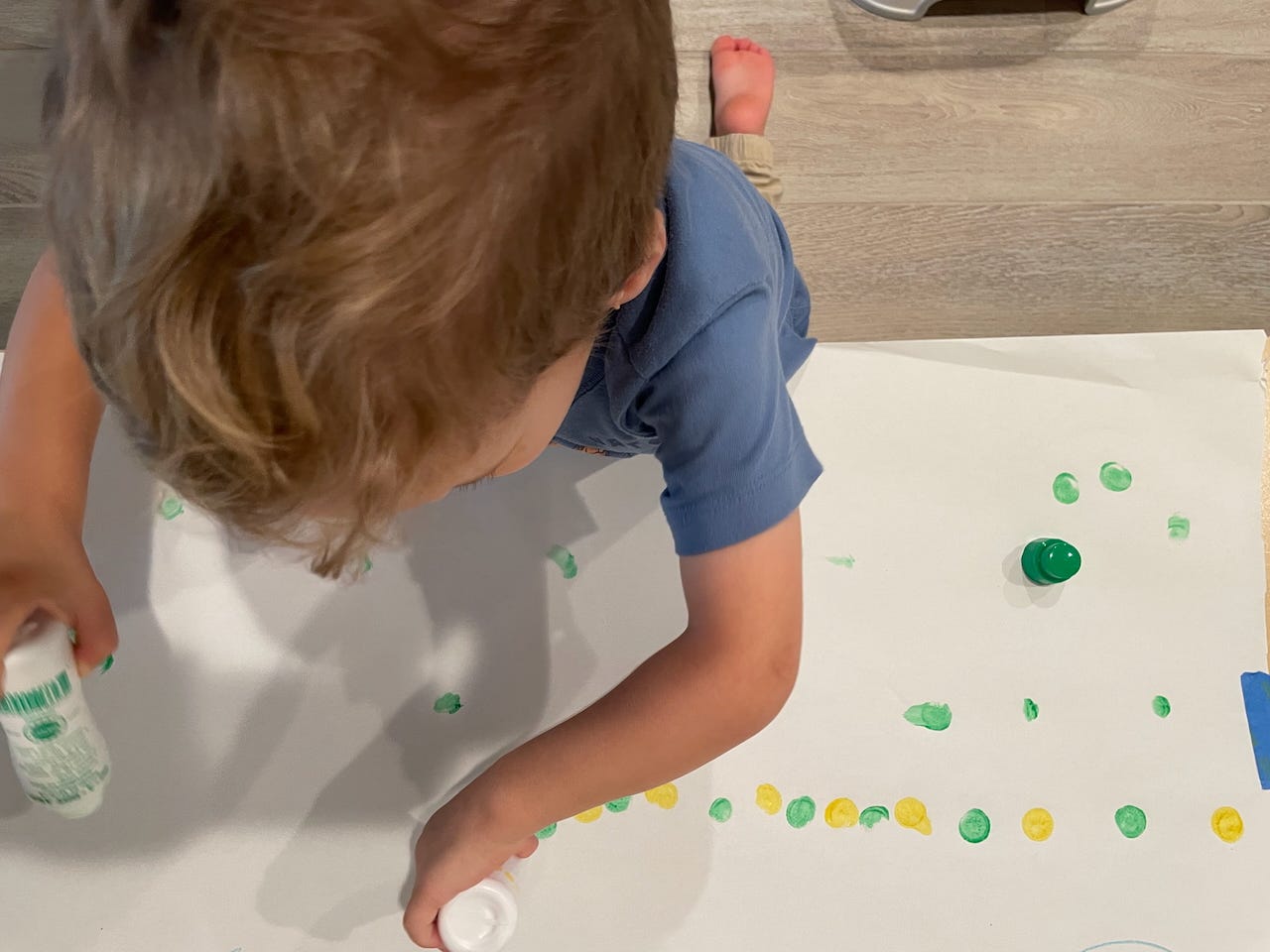I want my kids to have a different experience learning math than I did.
I didn’t enjoy math when I was in school, largely because it was taught through abstract concepts and memorization, with little connection to real life. In hindsight, I wish math had been presented in a more concrete and relatable way.
So when Hayden showed interest in numbers and quantities at around 2.5 years old, I decided to seize the opportunity to foster a positive relationship with math. My focus is on understanding, not memorizing, and on making math meaningful, hands-on, and relevant. To do that, I've been using simple games that you can play using items from around the house to learn numbers, quantities, patterns, fractions, and shapes.
Numbers and Quantities
1. Identify numbers
I began by making sure Hayden was familiar with numbers 1 through 10 and could easily recognize them. To do this, I created a simple drawing, say of some stick figures, trees, and a house, and scattered numbers throughout. Then, I wrote the same numbers on dot stickers. Hayden would match the sticker on the drawing. Hayden loves stickers and matching games, so this activity was a hit.
2. Sticker column challenge
I wanted Hayden to understand that each number represents a quantity. So I drew a few columns on a piece of paper and wrote a number at the bottom of each column. Hayden’s goal was to put the correct number of stickers in each column. For example, the column with “1” would have 1 sticker.
This activity worked really well because Hayden could clearly see which column had the most stickers and which had the fewest.
3. Roll a die and identify a number
Using a die is a simple way to get practice with quantities. Plus, rolling a die is such a thrill for a toddler!
Initially, Hayden rolled a die and counted the number of dots on the side he rolled. Then, I wrote the number on a piece of paper. That way, he could see that 3 dots, for example, corresponded to the number 3.
To take it up a notch, I placed individual pieces of paper numbered 1 through 6 on the floor. After rolling the die, Hayden would grab the corresponding number. For example, if he rolled a 6, he would pick up the paper with the number 6.
4. Feed the dino (or anything else your toddler loves)
Hayden loves dinosaurs, so this game has been a hit for a long time. To start, I place a dinosaur sticker on a piece of paper and have a sheet or two of dot stickers ready to be the "food" for the dino.
Hayden rolls the die (again, so much fun for a toddler), and the number he rolls determines how many pieces of “food” he feeds the dino. For example, if he rolls a 3, then he pulls off 3 stickers to feed the dino. Then, he rolls again. Sometimes instead of stickers, we’ll use dot markers. For each roll, he feeds the dino that many dots.
5. Build the tower
In this game, Hayden rolls the die and builds a tower based on the number he rolls. For example, if he rolls a 2, then he adds 2 blocks to his tower.
Instead of a die, you can also cut up pieces of paper with numbers written on them. Then, your toddler picks a number from the pile and builds the tower accordingly.
6. Number and quantity match
In this activity, I write numbers on one side of a piece of paper. On the other side, I draw small boxes; each box contains a certain number of dots. Hayden’s goal is to draw a line matching the number to the box with corresponding dots. For example, the number 2 is matched with the box that contains 2 dots.
7. Dot boxes with stickers
On a piece of paper, I draw boxes and fill each one with a certain number of dots. For example, I’ll draw 10 boxes, with each box containing a quantity of dots from 1 to 10. Then, I use a sheet of dot stickers and write the number corresponding to each box of dots.
Hayden’s goal is to match the number on the sticker with the box that has the same number of dots. So the sticker with the number 6 should be matched with the box with 6 dots.
I find it useful to use butcher paper for this activity. That way, I can make the boxes and dots large, which makes it easier for Hayden to count.
8. Let them help
Toddlers love to run and fetch things. So let them—and tie a number to it.
When I’m changing Marie’s diaper, I’ll ask Hayden to get me one diaper. When it’s time for dinner, I’ll ask him to get four placemats. When we have a pretend picnic, I’ll ask Hayden to get certain quantities of items from the pantry.
9. Build an ice cream cone
Hayden loves ice cream, so this game is a hit. I cut out some cones (brown triangles), write a number on each one, and put them on a large piece of butcher paper. I also have a bunch of dot stickers, which function as ice cream scoops. The goal is to put the correct number of scoops (dot stickers) on each cone.
10. Make a number line
Hayden loves to make a number line. I use a piece of paper and some dot stickers. Each sticker has a number 1 through 10. The goal is to arrange the stickers in the correct order to create a number line.
Patterns, Fractions, and Shapes
1. Calendar countdown
At the start of December last year, I took a wall calendar and showed Hayden how to “countdown to Christmas” using an AB pattern.
He loved it. Each morning he was eager to write X or O to mark off the day. The thrill hasn’t worn off, and it remains a part of our daily routine today. This activity is a great way to introduce patterns and larger numbers.
2. Patterns on paper
It’s fun to start a pattern and have your toddler finish it. One morning, I wrote “XO” on a piece of paper and asked Hayden what came next. After he filled the page with a bunch of Xs and Os, we moved on to another pattern.
To keep things interesting, I also make patterns using stickers, dot markers, and ink stamps—all things Hayden enjoys using.
3. Make a necklace
Hayden loves to make necklaces. This is another way to incorporate patterns and counting. Last week, he threaded Cheerios on a shoelace. He separated every ten Cheerios with a small piece of paper.
4. Fractions
Kitchen activities offer a variety of math opportunities, including learning about fractions. Hayden loves to cut up fruit, so I use these moments as an opportunity to talk about fractions.
Initially, I cut a banana or apple in half and then put the halves together to demonstrate that two halves make a whole. He thought this was so fun! Recently, I’ve started introducing the concept of ¼, using the same approach.
5. Shapes
Shapes have taken on a new fascination. There are a few simple shape games we like to play:
Point out a particular shape and count the number of times you see it. At the library today, Hayden counted the squares in the carpet. During a meal, he’ll count the number of rectangles he sees, such as the placemats, table, and napkins.
Count the sides of a particular shape. This is another simple game to do at mealtime by counting the sides of a placemat or napkin.
There are a few key themes in the math games I play with Hayden. First, I create games using things Hayden already enjoys, like stickers, dinosaurs, and ice cream. Second, I repeat similar concepts in different ways and different contexts to ensure Hayden really understands the idea. And, third, I actively involve Hayden in the learning process—he’s an active participant, not a passive observer. These are essential aspects of learning, no matter the subject.
The result is not only building a strong foundation of math knowledge. But also fostering a passion for a subject that many dread. It’s not the subject itself, but the way it’s taught that can dramatically impact one’s attitude toward it. My hope is that by focusing on understanding rather than memorization, and making math tangible and meaningful, Hayden will continue to enjoy learning math.
"Mathematics should be fun. If it’s not fun, you’re not doing it right."
–Edsger Dijkstra










